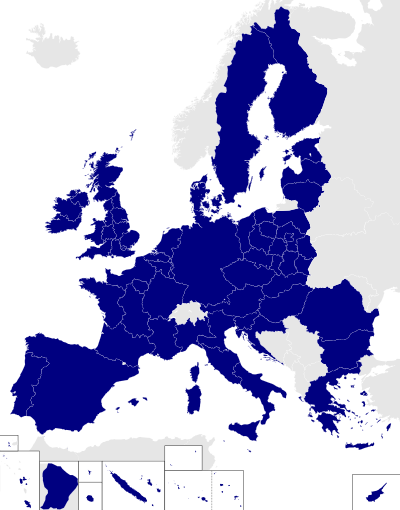Comitology
| European Union |
 This article is part of a series on the |
Policies and issues
|
Comitology in the European Union refers to a process by which EU law is modified or adjusted and takes place within "comitology committees" chaired by the European Commission.[1] The official term for the process is committee procedure.[2] Comitology committees are part of the EU's broader system of committees that assist in the making, adoption, and implementation of EU laws.[3] The comitology system was reconfigured by the Lisbon Treaty which introduced the current Articles 290 and 291 TFEU. Whereas Article 291 TFEU provides for a continuation of implementation of EU law through comitology, Article 290 TFEU introduced the delegated act which is now used to amend or supplement EU legislation, whereas beforehand this was also done through comitology.
Overview
All legislatures have a system of delegating detailed implementing measures to the executive. At EU level too, the European Parliament and the Council of the European Union can confer such powers on the Commission. However, the Commission must act in conjunction with committees of representatives of member states who often have the power to block the Commission and refer the matter to the Council.[4]
It is the confusing number of committees that gave rise to the term "comitology". A report from the British House of Lords[5] said, "There is no definitive list of comitology committees, their functions, activities and membership"; however, since the European Commission started to maintain a list, it states that "A list of 'comitology' committees [...] is published as an Annex to the Annual reports on the work of these Committees [...] as well as in the Register of Comitology.[6]" Moreover, the strongest criticism pertained to the fact that the elected European Parliament (EP) had no right to block implementing measures: only the comitology committees could do so, and if they did, the proposal was referred to Council alone, even when the initial delegation of powers was through an act adopted jointly by both Parliament and Council under the co-decision procedure. Parliament argued that the system lacked transparency and democratic control.
After years of complaint by Parliament, a significant reform placing Parliament and Council on an equal footing was to be introduced by the Constitutional Treaty. Since the latter did not get ratified, the Parliament insisted that the envisaged changes would be introduced through secondary law. An agreement was reached in 2006 and a new procedure, the regulatory procedure with scrutiny, was introduced, to be used when non-essential elements of EU legislation adopted under the co-decision procedure required amendment or supplementation.
The procedure gives Parliament and Council a period (normally of three months) to examine proposals that have been through a comitology committee. If Parliament objects to a proposal, the Commission cannot enact it. Instead, the Commission can either make a new proposal, taking account of the reasons for the objection (in which case the clock is re-set and Parliament can again block), or it can propose new legislation to Parliament and Council under the legislative co-decision procedure.
The new procedure applies whenever Council and Parliament, under co-decision on the basic legislation, choose to confer powers on the Commission to adopt implementing measures of general scope that can be described as "quasi-legislative" in nature (delegated legislation). It does not apply to administrative or purely executive decisions. The system does not apply when the original legislation is not co-decision legislation. Then, the old comitology procedures (see below) can still apply.
Second comitology decision
The comitology system was initially not foreseen under the EEC Treaty. The Single European Act introduced a legal basis for the first time and instructed the Council to adopt a Decision setting out the different procedures. This was the first Comitology decision of 1987. The Parliament had also pressed for more transparency in the comitology system. Already in 1999, it secured the Council's agreement in a Council of the European Union decision 28 June 1999 on procedures for the exercise of implementing powers conferred on the Commission (1999/468/EC;[7] OJ L 184/23 of 17 July 1999) ("the Comitology Decision") that references of the documents transmitted be made available to the public (Article 7 paragraph 5).
The Commission was, therefore, obliged to create a register of Comitology documents and a web-based repository to the register which enables the user to get direct access to certain documents which also contains a link for requesting the document, if it is not made public in the repository (in accordance with the rules of the Regulation No. 1049/2001 of the European Parliament and of the Council of 30 May 2001 (OJ L 145/43 of 31 May 2001)).
The register in general contains the following types of documents:
- agendas of committee meetings,
- draft implementing measures,
- summary records of committee meetings,
- voting results of opinions delivered by a committee.
Comitology regulation
A new regulation on comitology was adopted pursuant to Article 291 (3) TFEU. It is in force since 1 March 2011 (Regulation No 182/2011)[8] of the European Parliament and of the Council laying down the rules and general principles concerning mechanisms for control by Member States of the Commission's exercise of implementing powers)
Types of committee
Under the second comitology decision of 1999 (amended in 2006) there were four categories of committee: Advisory, Management, Regulatory and, under the procedure agreed in 2006, Regulatory with Scrutiny. Advisory committees give opinions which the Commission must take account of, but it retains the power of decision. Management committees can block a proposed Commission measure by a qualified majority. A Regulatory committee needs a qualified majority to approve a proposed Commission measure. Measures not adopted are referred to the Council for a decision (or Council and Parliament under the new Regulatory committee with Scrutiny, where opposition from either will block the proposed measure).[4]
The Comitology regulation has only retained the advisory procedure, and replaced the management and regulatory procedures with the examination procedure. Under the Lisbon Treaty, the scenarios in which the regulatory procedure with scrutiny applied are now covered by the delegated act foreseen in Article 290 TFEU.
Democratic legitimacy
As noted above, the European Parliament has long had a problem with the lack of transparency of comitology committees, stemming mainly from the fact that Members of the European Parliament (MEPs) are excluded from the comitology process. A broader concern has been voiced about the public accountability of comitology. As sites of European governance which produce a vast amount of binding legislation, comitology's opaque mode of operation, unclear membership, and closed debate style has been the subject of criticism from both academics[3] and practitioners.
See also
References
- ↑ Hardacre, Alan; Kaeding, Michael (September 2011). "Delegated and implementing acts: The new worlds of comitology – implications for European and national public administrations" (pdf). Eipascope, special issue: 30th Anniversary. European Institute of Public Administration (EIPA). 1: 29–32. ISSN 1025-6253
- ↑ European Court of Auditors: Misused English terminology in EU publications
- 1 2 Rhinard, Mark (April 2002). "The democratic legitimacy of the European Union committee system". Governance. Wiley. 15 (2): 185–210. doi:10.1111/1468-0491.00185.
- 1 2 "Glossary: Comitology". eur-lex.europa.eu. EUR-Lex.
- ↑ Select Committee on European Communities – Third Report. House of Lords. 2 February 1999. 10510/98 (COM(98) 297).
- ↑ "Comitology Register". ec.europa.eu. European Commission.
- ↑ "Council decision of 28 June 1999 laying down the procedures for the exercise of implementing powers conferred on the Commission". eur-lex.europa.eu. EUR-Lex. Pdf.
- ↑ "Regulation No 182/2011". eur-lex.europa.eu. EUR-Lex. Pdf.
Further reading
- Nedergaard, Peter; Nørgaard, Rikke Wetendorff; Blom-Hansen, Jens (July 2014). "Lobbying in the EU comitology system". Journal of European Integration. Taylor and Francis. 36 (5): 491–507. doi:10.1080/07036337.2014.889128.
- See also: Bouwen, Pieter (September 2004). "The logic of access to the European Parliament: business lobbying in the Committee on Economic and Monetary Affairs". Journal of Common Market Studies. Wiley-Blackwell. 42 (3): 473–495. doi:10.1111/j.0021-9886.2004.00515.x.
- and: Bouwen, Pieter (December 2003). "A theoretical and empirical study of corporate lobbying in the European Parliament". European Integration Online Papers (EIOP). 7. Pdf.
- See also: Bouwen, Pieter (September 2004). "The logic of access to the European Parliament: business lobbying in the Committee on Economic and Monetary Affairs". Journal of Common Market Studies. Wiley-Blackwell. 42 (3): 473–495. doi:10.1111/j.0021-9886.2004.00515.x.
External links
- Consolidated Version of Comitology Decision 1999/468/EC taking into consideration Decision 2006/512/EC of 17 July 2006
- Web-based access to the Comitology register
- Acquis on Comitology
- More background
- Detailed Bibliography on Comitology
- EEA EFTA on Comitology
- Papers at the University of Pittsburgh
- A short, to-the-point summary table on comitology procedures on Online EU Tests



